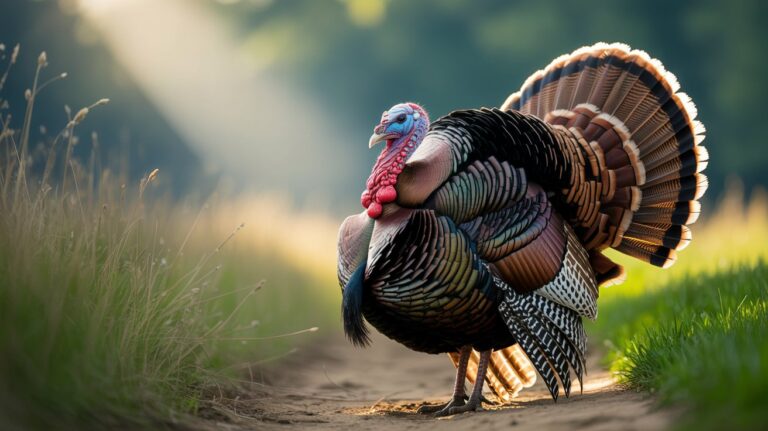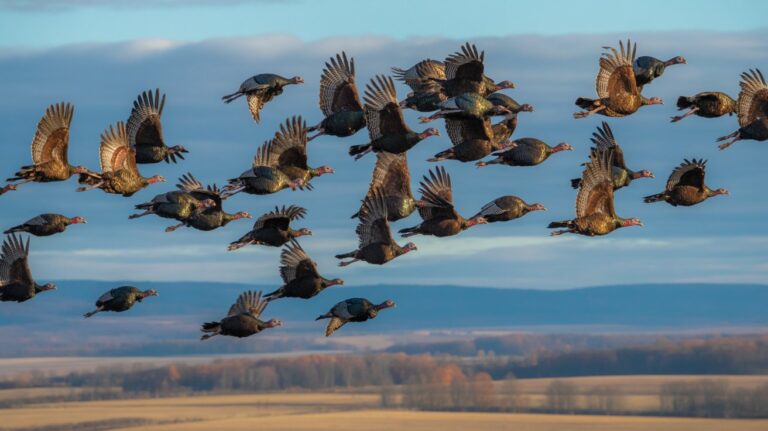Turkeys come in different colors based on their breed, age, and environment. Wild turkeys have brown, black, and bronze feathers with an iridescent shine, while domestic turkeys are usually white. Their head, beak, and skin also change colors based on mood and health.
This article explores the colors of turkeys, their feathers, eggs, and beaks, and how their appearance changes over time. Understanding turkey colors can help farmers, hunters, and bird enthusiasts learn more about these unique birds.
Turkey Feather Colors
Turkeys have different feather colors depending on their type and breed.
- Wild turkeys have a mix of brown, black, bronze, and green feathers. These colors help them blend into forests and avoid predators.
- Domestic turkeys are mostly white. Farmers breed them this way because white feathers do not leave dark spots on processed meat.
- Heritage turkeys have unique colors like black, brown, blue, and reddish feathers. They are raised for meat and conservation purposes.
Feathers protect turkeys from weather changes, keep them warm, and play a role in attracting mates. The shine on wild turkey feathers, called iridescence, makes them look different in sunlight.
Wild Turkey Coloration
Wild turkeys have a striking appearance that helps them survive in the wild.
- Their feathers have a mix of brown, black, and bronze shades with a greenish or purplish shine.
- Males have shinier and more colorful feathers than females to attract mates.
- Females have duller feathers to help them hide while nesting.
The dark colors of wild turkeys help them blend into their surroundings, making it harder for predators to spot them.
Domestic Turkey Colors
Farm-raised turkeys are usually bred for meat production. Their colors are different from wild turkeys.
- White turkeys are the most common because their feathers do not leave dark spots on the meat.
- Some farms raise black, brown, or bronze turkeys for special markets.
- Heritage breeds like Bourbon Red and Narragansett turkeys have unique feather colors.
Domestic turkeys are bred for size and appearance rather than survival in the wild.
What Color is a Turkey Egg?
Turkey eggs look different from chicken eggs in both size and color.
- They are light brown, cream, or speckled with small dark spots.
- The shells are thicker than chicken eggs, making them harder to crack.
- Wild turkey eggs are darker than domestic turkey eggs for better camouflage.
Most people do not eat turkey eggs because turkeys lay fewer eggs than chickens, and farmers prefer to use them for breeding.
What Color is a Turkey’s Beak?
The color of a turkey’s beak can change as the bird grows.
- Young turkeys have light pink or yellow beaks.
- Adult turkeys usually have gray, black, or dark brown beaks.
- Beaks can turn bluish or reddish when turkeys are excited or stressed.
A turkey’s beak helps it eat seeds, insects, and small plants. It is an essential tool for survival.
Turkey Head Color Meaning
A turkey’s head color changes depending on its mood and health.
- A red head means the turkey is excited, angry, or ready to mate.
- A blue or white head can indicate calmness or stress.
- Males have brighter head colors than females, especially during mating season.
Blood flow controls these color changes, making the turkey’s head a signal of its emotions.
Turkey Skin Color Changes
The skin of a turkey changes based on its mood and environment.
- When calm, the skin appears light pink or pale.
- When excited, scared, or aggressive, the skin turns red, blue, or purple.
- Changes in blood circulation cause these color shifts.
Turkeys use their skin color to communicate with other turkeys and warn of danger.
Albino Turkeys
Albino turkeys are extremely rare and look different from normal turkeys.
- They have white feathers, pink skin, and red eyes.
- Albino turkeys lack melanin, which gives color to feathers and skin.
- They struggle to survive in the wild because they stand out to predators.
Some farms breed albino turkeys for their unique appearance.
Melanistic Turkeys
Melanistic turkeys have extra dark feathers due to excess melanin.
- Their feathers are black with a green or purple shine.
- They are uncommon but found in some wild turkey populations.
- This condition makes them look different from regular wild turkeys.
Melanistic turkeys are just as strong and healthy as normal turkeys.
Erythristic Turkeys
Erythristic turkeys have unusual red or orange feathers.
- This rare color comes from a genetic mutation.
- They stand out from regular wild turkeys.
- Some hunters and researchers study these turkeys because of their unique appearance.
Erythristic turkeys are one of the rarest color variations.
Color-Phase Turkeys
Color-phase turkeys have special feather colors due to genetics.
- Some have white, brown, or gray feathers instead of traditional colors.
- These colors appear naturally in some turkey populations.
- Different turkey breeds have different color phases.
People enjoy raising and studying color-phase turkeys because of their unique look.
Does Turkey Feather Color Affect Behavior?
Feather color does not change how turkeys act.
- Wild turkeys are alert and active, no matter their color.
- Domestic turkeys are calmer because they are raised on farms.
- Bright-colored turkeys may be easier for predators to spot.
Feather color mostly helps turkeys blend into their environment and attract mates.
Why Do Some Turkeys Look Shiny?
Some turkeys have feathers that shine in the sunlight.
- This effect is called iridescence.
- It makes feathers look green, purple, bronze, or blue under certain lights.
- Iridescence helps turkeys attract mates.
Males have shinier feathers than females, especially during mating season.
Turkey Egg vs. Chicken Egg Color
Turkey eggs are different from chicken eggs in many ways.
- Turkey eggs are larger, thicker, and speckled.
- Chicken eggs are smaller and come in white, brown, or blue shades.
- Most people do not eat turkey eggs because turkeys lay fewer eggs.
Turkey eggs are mainly used for breeding rather than food.
Conclusion
Turkeys come in many colors depending on their breed, environment, and genetics. Wild turkeys have dark, shiny feathers that help them blend into their surroundings, while domestic turkeys are often white for easier processing. Turkey eggs are light brown and speckled, and their beaks and skin change color based on mood. Rare turkeys, like albino and melanistic ones, show how diverse these birds can be. Understanding turkey colors helps people appreciate their beauty and role in nature.
FAQs
1. Why does my ground turkey turn grayish after a few days?
Ground turkey can turn gray due to oxidation. It’s safe if properly stored and odor-free but should be cooked or frozen promptly.
2. Can turkeys see in color?
Yes, wild turkeys see in color and have excellent daytime vision, which is three times better than human eyesight, and covers 270 degrees.
3. What does it mean if a turkey’s head is blue?
A turkey’s head color changes with emotions. A blue head often indicates calmness, while red signifies excitement or aggression.
4. Is it safe to eat slightly pink turkey meat?
Yes, as long as the turkey reaches an internal temperature of 165°F, slight pinkness is safe due to hemoglobin interactions.
5. Why does turkey meat sometimes appear darker?
Turkey meat color varies due to myoglobin levels. Darker meat has more myoglobin, common in muscles used more frequently by the bird.





